Reported Aircraft Down In Your 1st Due: Would you know what to do?
Do you live near a small municipal, large commercial or international airport, or even a military air base? Would you know how to respond, what to do, what tactics to employ? Did you know that aircraft are most susceptible to crashing upon take off and landing, ascent and descent? This gives you about a 20 to 30 minute drive time, time frame from the airport. Do you live within that time frame?
Following are some tactics to employ and pointers. I am no ARFF(Airport Rescue Firefighting) expert or ARFF instructor, but I am an ARFF certified firefighter. And I encourage anyone with ARFF experience to contribute to this thread. As well as those with none, ask questions, I'll answer them to the best of my ability, if I can.
You can usually expect one of two things when responding to the report of an aircraft down. One, the aircraft simply made a hard landing and the fuselage is intact, resulting in anything from slight injury to crew and passengers, most being walking wounded, to severe trauma and/or death. Or, two, the aircraft has crashed and you will encounter complete, total and utter carnage, with the probability of survival being minimal. In this case, you will most likely find body parts instead of whole people. Be prepared to see the worst. CISD will need to be employed.
Examples of a hard landing:
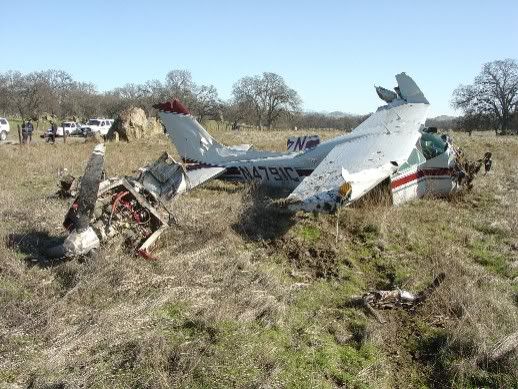
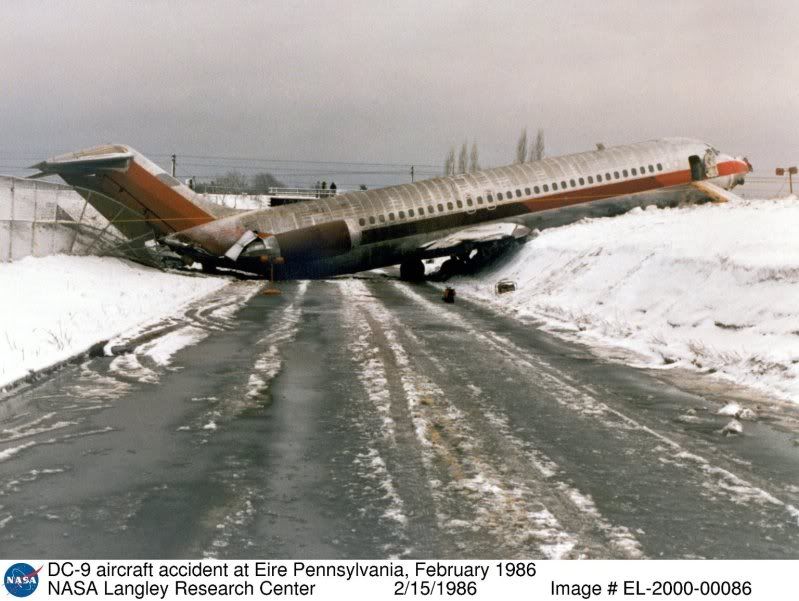

Examples of a crash:
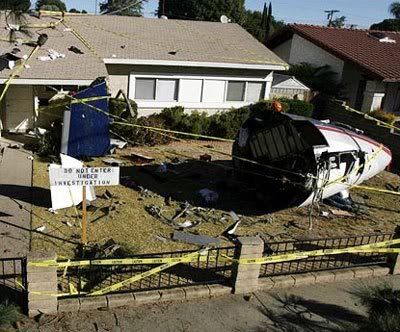
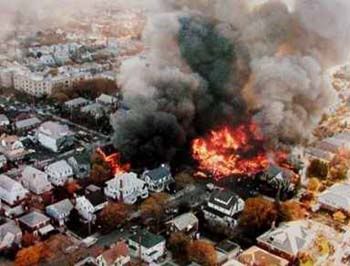
Do not move any pieces of the aircraft unless you absolutely have to, to necessitate a rescue. It needs to be treated as you would a crime scene.
If you encounter an aircraft down with the fuselage intact, with fire involvement, time is of the essence. Burn-through time on aluminum fuselages is usually less than 1(ONE) minute. Make sure you wear your SCBA! Many aircraft today are made with composite materials, as well as aluminum. Composite materials are a known cancer causing agent. Aircraft fires will involve large Class B fires. Class B foam or AFFF will be required. Set up apparatus and attack the fire at a 45º angle from the fuselage, on both sides of the aircraft. A rescue path needs to be cut, and maintained at all times, toward the fuselage with handlines, using the roll-on method to apply the foam.
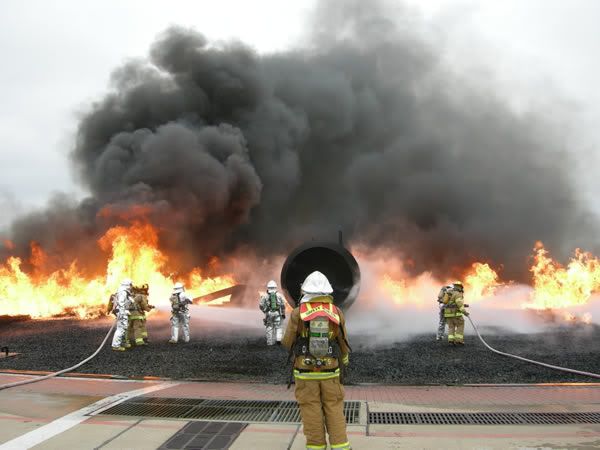
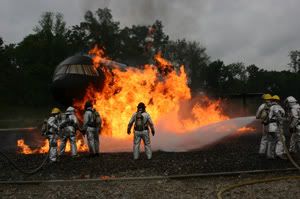
Once you reach the fuselage you need to make entry. Remember, just like a vehicle crash or forcible entry into a structure, try before you pry. Most aircraft doors are clearly marked with easy instructions on how to open the door.
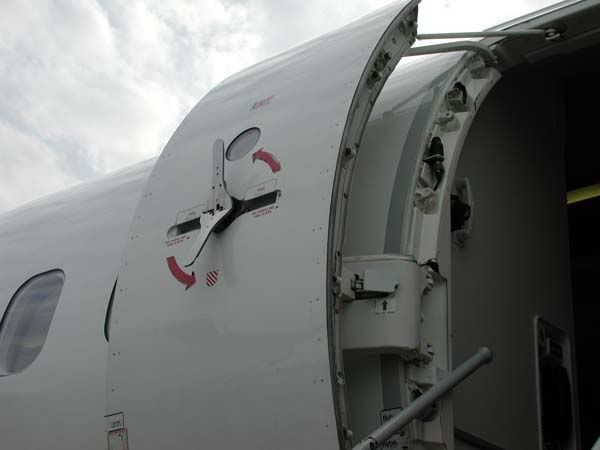
Employ ground ladders, place them directly at the door. Or if there are emergency escape doors over the wing place the ladder as close to the fuselage as possible with the top of the ladder over the wing as you would a structure, two or three rungs. A K-12 saw with a carbide tipped blade is best to use, warthog blades work well, too.
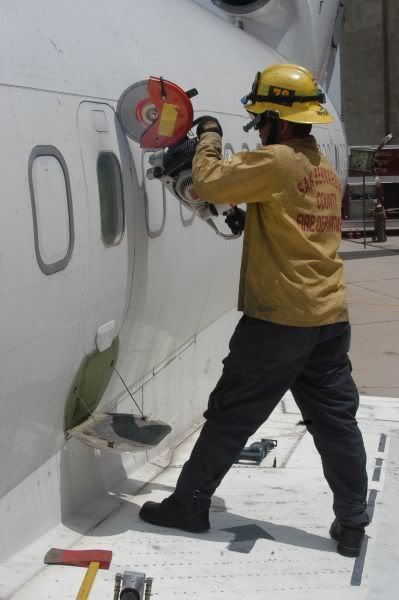
Employ a piercing nozzle if you have one, flood the fuselage passenger compartment, it will buy you time and hopefully keep those inside alive. Foam is not necessarily needed in this instance.
If you encounter an engine nacelle fire, flood the engine. Be very cautious and aware of jet engine intakes and prop aircraft propellers. Approach at a slight angle and keep your distance until the engine has shut down. If the pilot is unable to shut the engines down flooding the nacelle will do so.
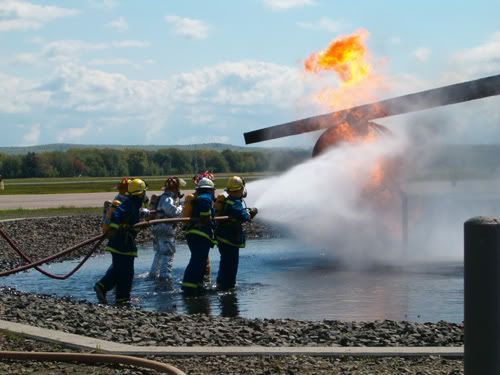
If you encounter an aircraft crash where the fuselage is intact with no fire, but leaking fuel, apply and maintain a thick foam blanket, and take away all ignition sources.
Think big picture, don't hesitate to call for mutual aid and upgrade your alarm. If it's a large aircraft activate an MCI immediately. You will need lots of foam, and lots of manpower. As well as your regular mutual aid, airport and military ARFF units are more than willing to respond and help out. They have the apparatus specifically designed to deal with this type of emergency. Though the ARFF truck is much larger than our normal engines and ladders, they are small enough to drive and navigate city streets and country roads. And they're agile enough to go where our engines and ladders can't, into the wilderness.
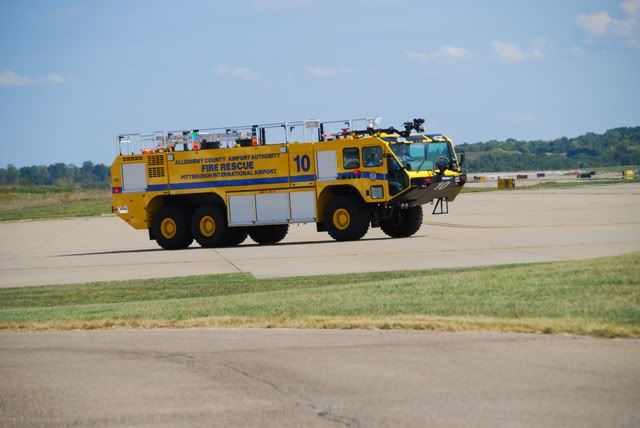
Lastly, train with them. Most commercial airport and military airbase ARFF units are more than willing to offer classes and hands on training.
Following are some tactics to employ and pointers. I am no ARFF(Airport Rescue Firefighting) expert or ARFF instructor, but I am an ARFF certified firefighter. And I encourage anyone with ARFF experience to contribute to this thread. As well as those with none, ask questions, I'll answer them to the best of my ability, if I can.
You can usually expect one of two things when responding to the report of an aircraft down. One, the aircraft simply made a hard landing and the fuselage is intact, resulting in anything from slight injury to crew and passengers, most being walking wounded, to severe trauma and/or death. Or, two, the aircraft has crashed and you will encounter complete, total and utter carnage, with the probability of survival being minimal. In this case, you will most likely find body parts instead of whole people. Be prepared to see the worst. CISD will need to be employed.
Examples of a hard landing:



Examples of a crash:


Do not move any pieces of the aircraft unless you absolutely have to, to necessitate a rescue. It needs to be treated as you would a crime scene.
If you encounter an aircraft down with the fuselage intact, with fire involvement, time is of the essence. Burn-through time on aluminum fuselages is usually less than 1(ONE) minute. Make sure you wear your SCBA! Many aircraft today are made with composite materials, as well as aluminum. Composite materials are a known cancer causing agent. Aircraft fires will involve large Class B fires. Class B foam or AFFF will be required. Set up apparatus and attack the fire at a 45º angle from the fuselage, on both sides of the aircraft. A rescue path needs to be cut, and maintained at all times, toward the fuselage with handlines, using the roll-on method to apply the foam.


Once you reach the fuselage you need to make entry. Remember, just like a vehicle crash or forcible entry into a structure, try before you pry. Most aircraft doors are clearly marked with easy instructions on how to open the door.

Employ ground ladders, place them directly at the door. Or if there are emergency escape doors over the wing place the ladder as close to the fuselage as possible with the top of the ladder over the wing as you would a structure, two or three rungs. A K-12 saw with a carbide tipped blade is best to use, warthog blades work well, too.

Employ a piercing nozzle if you have one, flood the fuselage passenger compartment, it will buy you time and hopefully keep those inside alive. Foam is not necessarily needed in this instance.
If you encounter an engine nacelle fire, flood the engine. Be very cautious and aware of jet engine intakes and prop aircraft propellers. Approach at a slight angle and keep your distance until the engine has shut down. If the pilot is unable to shut the engines down flooding the nacelle will do so.

If you encounter an aircraft crash where the fuselage is intact with no fire, but leaking fuel, apply and maintain a thick foam blanket, and take away all ignition sources.
Think big picture, don't hesitate to call for mutual aid and upgrade your alarm. If it's a large aircraft activate an MCI immediately. You will need lots of foam, and lots of manpower. As well as your regular mutual aid, airport and military ARFF units are more than willing to respond and help out. They have the apparatus specifically designed to deal with this type of emergency. Though the ARFF truck is much larger than our normal engines and ladders, they are small enough to drive and navigate city streets and country roads. And they're agile enough to go where our engines and ladders can't, into the wilderness.

Lastly, train with them. Most commercial airport and military airbase ARFF units are more than willing to offer classes and hands on training.
Tags:
Replies to This Discussion
-
Permalink Reply by Paul Montpetit on January 19, 2010 at 4:31pm
-
Doug, pretty good job man.....Don't forget that the wheels have bolts that will literally explode and shoot out to the side of the aircraft...so you need to approach from a 45 degree angle...and NEVER EVER forget to pay attention and watch ALL AROUND you.....one man on the nozzle and at least one on the line with him watching the 6 o'clock.....if you find your self in the foam blanket not to worry....walk gently as to not disrupt the foam blanket...you should train on the different aircraft likely to deal with...learn where the extinguisher deployment valves are and how to deploy them in case the pilot is disabled (or worse)...also disable the batteries as to kill any future ignition source....and call in as much help as you can...mutual aid....no matter how much you have it won,t be enough.........Paul
-
Permalink Reply by Doug on January 19, 2010 at 4:56pm
-
Good point about the aircraft wheels and breaks. It is best to use dry chem on those if they are the only part of the aircraft involved in fire, they're usually made from magnesium.
Also, about the onboard extinguishing agents for engine nacelles or the luggage compartment, on most aircraft they are located in the center of the cockpit, between the pilot and co-pilot, marked with red handles, either at waist level or overhead.
-
Permalink Reply by Paul Montpetit on January 19, 2010 at 5:16pm
-
A few years ago we had a small commuter come in for a landing and hit a coyote with the front landing gear....No big damage...plane slid off the runway....coyote had better days though...it was mangled into the landing gear...
-
Permalink Reply by Mike Schlags (Captain Busy) Retd on January 19, 2010 at 5:23pm
-
Excellent post with the time you spent preparing this being clearly obvious. The only thing I can add to this is that the crash scene becomes the responsibility of the FAA and NTSB. These incidents are investigated and must be created no differently than a crime scene. In my jurisdiction, the Sheriff's Department is also the coroner.
On a side note, the last experimental plane crash I responded to resulted in my offering the NTSB guys a place to stay at my house, which they took me up on. They did not have a budget for motel rooms and would have had to drive several hours away, only to return the next morning when there was better light. I mention this because any of you might find yourself in a situation where you are working with these guys. At least consider offering them a bed at the fire station. They will really appreciate it and you will learn more about cause and origin of the problems through osmosis... :D
You also have to consider body recovery issues and working with coroner to remove what's left... This part of responding to these incidents fully sucks...
CBz
-
Permalink Reply by Firefighter Walther on January 19, 2010 at 6:29pm
-
hmm, very interesting read, thanks for posting, learned something new!
-
Permalink Reply by Doug on January 19, 2010 at 8:08pm
-
This is a rare occurrence, even for seasoned ARFF firefighters. More often than not the engine(s) will already be shut down, either by the pilot, or from the damage. But, if need, as I stated, approach with extreme caution and from a slight angle, you don't want to go at it head on or at 90º, but you also want to approach at an angle greater than 45º, crouching down or duck walking will also help in greatly fighting the forces of the intake. You would be surprised at how close you can get to an intake before you really feel the effects and it wanting to suck you in, but I wouldn't recommend it. Surprisingly, not a whole lot of water or foam is needed to flood a jet engine nacelle, but a propeller driven aircraft is greater, as they are more enclosed. But they do have an intake, all-be-it much smaller than a jet engine, aim for it. You really can't put a fixed amount of how much water or foam is needed to accomplish this. Just keep at it until it stalls out.
-
Permalink Reply by Derek R. on January 19, 2010 at 8:59pm
-
Hey Doug, this is a great post. Thank you very much for the time you've taken to get this out to those who can benefit from it. I live in the neighboring district of a small airport. It used to be a main airway for the armed forces during WW2. Now just basically a training facility for new pilots. But,still, there are aircraft and gliders using it every day. There's a good chance we will be called for mutual aid if something big happens and this post has brought a lot of useful information to the table that our dept. can use.
Thanks
KSHF
-
Permalink Reply by lang on January 19, 2010 at 9:01pm
-
If you do encounter an engine that is still running, most commercial planes will have a cut in area outlined in red that says fire dept cut in. A K-12 or piercing nozzles will get you in. The same is true about the fuselage it will also have cut in areas marked same as the engine. Good thread Doug the only other things I can add is if you roll up on a crash and see people self extracating your first priorty is to protect them, next if you need to make entry find a different entry point to the plane. To shut down the aircraft just remember throttle bottles batteries. Thorttles will be in the middle of the of the capt and co-capt seats, bottles will also be in the middle of the instrument panel either right below the windows or right above the windows, battieries depend on the aircraft. One last thing the 2 side windows in the cock pit usually open can either be used for ventilation or an escape route so don't get tunnel vision and go right past that area of the plane
-
Permalink Reply by John Sees on January 19, 2010 at 10:44pm
-
Good post. The only plane crash that I have been involved in was a single engine private plane. It landed in a corn field about 2,000 feet from the station. Someone called 911 one night and said that they heard a plane with engine trouble, we looked for it on the way to the station, could not find any crashes so we sat at the station with the engines running and the lights on. The pilot saw the lights and though that was as good place as any to try to land. They found less than 8 oz. of fuel in his tanks. No one was hurt and they took the plane to an airport and flew it back home a couple days later. But I can walk out side any clear night and see at least one plane within a minute. So I think that I'll read this post again. Thanks.
-
Permalink Reply by Doug on January 19, 2010 at 11:00pm
-
Excellent points about throttles, bottles, batteries. That was drilled into my head as an Air Force firefighter, I can't believe I forgot to mention that, haha.
Another excellent point about the side windows of the cockpit and cutting areas outlined in red, using them for egress, fire suppression and ventilation. As far as I'm aware, on every single large-framed aircraft, the side cockpit windows do pop out.
Another point to bring up about windows, more specifically in large-framed aircraft and all military aircraft, do not even attempt to cut through them. You won't get anywhere. Cut around the metal/aluminum framing holding the windows in place. On small, private aircraft, aircraft that do not need to be pressurized, you can probably get away with it. But still, I wouldn't recommend that, cut the framing.
-
Permalink Reply by John Allen on January 19, 2010 at 11:16pm
-
Great post! I would have to question flooding the engines too Michael. As a former employee at an FBO I've seen jet engines turned on and sprayed with water to clean the engines (this is due to the pilot having a bird strike another story in itself) Now granted, it was a 1" garden hose and not an 1 3/4 fire hose. Most jet pilots I talked to about this said they didn't see the advantage of flooding an engine and didn't think it would assist in shutting them down. Catastropic failure could occur which could make it dangerous for you or your other FF's and viable patients. But I would love to give it a try!:)
Another thing to remember....the engines sustain enough heat for over 20 minutes once shut down to activate fuel fires. Kinda what they're designed to do:)
On the bird strike mentioned above......the pilot......who I don't want to leave nameless lol.....was not exactly Captain Sully. He advised he hit birds on take off....didn't "hear" anything different and flew the 2 hrs to where I was working. Closer inspection......after his passengers left....revealed numerous fins in the intake that were damaged. VERY lucky he didn't crash somwhere. Oh.....if the name Dr. Reed comes up......don't fly with him!:) One thing I've learned working the FBO.....you know who to fly with and more importantly.....who NOT to fly with. Check with your line service personnel at your local airport....they'll know!
Specialty Websites
Find Members Fast
Firefighting Videos
© 2026 Created by Firefighter Nation WebChief.
Powered by
![]()
Badges | Contact Firefighter Nation | Privacy Policy | Terms of Service